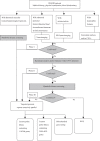Diagnosis of intellectual disability/global developmental delay via genetic analysis in a central region of China
- PMID: 31205075
- PMCID: PMC6616229
- DOI: 10.1097/CM9.0000000000000295
Diagnosis of intellectual disability/global developmental delay via genetic analysis in a central region of China
Abstract
Background: Advanced technology has become a valuable tool in etiological studies of intellectual disability/global developmental delay (ID/GDD). The present study investigated the role of genetic analysis to confirm the etiology in ID/GDD patients where the cause of the disease was uncertain in central China.
Methods: We evaluated 1051 ID/GDD children aged 6 months to 18 years from March 2009 to April 2017. Data concerning basic clinical manifestations were collected, and the method of etiology confirmation was recorded. Genome-wide copy number variations (CNVs) detection and high-throughput sequencing of exons in the targeted regions was performed to identify genetically-based etiologies. We compared the incidence of different methods used to confirm ID/GDD etiology among groups with differing degrees of ID/GDD using the Chi-square or Fisher exact probability test.
Results: We recruited 1051 children with mild (367, 34.9%), moderate (301, 28.6%), severe (310, 29.5%), and profoundly severe (73, 6.9%) ID/GDD. The main causes of ID/GDD in the children assessed were perinatal factors, such as acquired brain injury, as well as single gene imbalance and chromosomal gene mutation. We identified karyotype and/or CNVs variation in 46/96 (47.9%) of cases in severe ID/GDD patients, which was significantly higher than those with mild and moderate ID/GDD of 34/96 (35.4%) and 15/96 (15.6%), respectively. A total of 331/536 (61.8%) patients with clear etiology have undergone genetic analysis while 262/515 (50.9%) patients with unclear etiology have undergone genetic analysis (χ = 12.645, P < 0.001). Gene structure variation via karyotype analysis and CNV detection increased the proportion of children with confirmed etiology from 51.0% to 56.3%, and second-generation high-throughput sequencing dramatically increased this to 78.9%. Ten novel mutations were detected, recessive mutations in X-linked genes (ATPase copper transporting alpha and bromodomain and WD repeat domain containing 3) and dominant de novo heterozygous mutations in X-linked genes (cyclin-dependent kinase like 5, protocadherin 19, IQ motif and Sec7 domain 2, and methyl-CpG binding protein 2) were reported in the study.
Conclusions: The present study indicates that genetic analysis is an effective method to increase the proportion of confirmed etiology in ID/GDD children and is highly recommended, especially in ID/GDD children with uncertain etiology.
Figures
Similar articles
-
Diagnostic approach with genetic tests for global developmental delay and/or intellectual disability: Single tertiary center experience.Ann Hum Genet. 2019 May;83(3):115-123. doi: 10.1111/ahg.12294. Epub 2018 Nov 6. Ann Hum Genet. 2019. PMID: 30402882
-
Application of chromosomal microarrays in the evaluation of intellectual disability/global developmental delay patients - A study from a tertiary care genetic centre in India.Gene. 2016 Sep 15;590(1):109-19. doi: 10.1016/j.gene.2016.06.020. Epub 2016 Jun 9. Gene. 2016. PMID: 27291820
-
[Application of single nucleotide polymorphism-microarray and target gene sequencing in the study of genetic etiology of children with unexplained intellectual disability or developmental delay].Zhonghua Er Ke Za Zhi. 2016 Oct 2;54(10):740-745. doi: 10.3760/cma.j.issn.0578-1310.2016.10.006. Zhonghua Er Ke Za Zhi. 2016. PMID: 27784475 Chinese.
-
Updates in the genetic evaluation of the child with global developmental delay or intellectual disability.Semin Pediatr Neurol. 2012 Dec;19(4):173-80. doi: 10.1016/j.spen.2012.09.004. Semin Pediatr Neurol. 2012. PMID: 23245550 Review.
-
Calcium channelopathies and intellectual disability: a systematic review.Orphanet J Rare Dis. 2021 May 13;16(1):219. doi: 10.1186/s13023-021-01850-0. Orphanet J Rare Dis. 2021. PMID: 33985586 Free PMC article. Review.
Cited by
-
Prevalence and Developmental Profiles of Autism Spectrum Disorders in Children With Global Developmental Delay.Front Psychiatry. 2022 Jan 18;12:794238. doi: 10.3389/fpsyt.2021.794238. eCollection 2021. Front Psychiatry. 2022. PMID: 35115968 Free PMC article.
-
Intellectual disability in two Chinese sisters caused by a 3p26.3p25.3 microdeletion and a 14q32.13q32.33 microduplication inherited from the mother with 46, XX, t (3, 14) (p25; q32).Mol Genet Genomic Med. 2020 Aug;8(8):e1335. doi: 10.1002/mgg3.1335. Epub 2020 Jun 2. Mol Genet Genomic Med. 2020. PMID: 32489010 Free PMC article.
-
Reliability, Consistency and Temporal Stability of Alberta Infant Motor Scale in Serbian Infants.Children (Basel). 2020 Mar 2;7(3):16. doi: 10.3390/children7030016. Children (Basel). 2020. PMID: 32131387 Free PMC article.
References
-
- Michelson DJ, Shevell MI, Sherr EH, Moeschler JB, Gropman AL, Ashwal S. Evidence report: genetic and metabolic testing on children with global developmental delay: report of the Quality Standards Subcommittee of the American Academy of Neurology and the Practice Committee of the Child Neurology Society. Neurology 2011; 77:1629–1635. doi: 10.1212/WNL.0b013e3182345896. - PubMed
-
- Maulik PK, Mascarenhas MN, Mathers CD, Dua T, Saxena S. Prevalence of intellectual disability: a meta-analysis of population-based studies. Res Dev Disabil 2011; 32:419–436. doi: 10.1016/j.ridd.2010.12.018. - PubMed
-
- Leonard H, Wen X. The epidemiology of mental retardation: challenges and opportunities in the new millennium. Ment Retard Dev Disabil Res Rev 2002; 8:117–134. doi: 10.1002/mrdd.10031. - PubMed
-
- Moeschler JB, Shevell M. Clinical genetic evaluation of the child with mental retardation or developmental delays. Pediatrics 2006; 117:2304–2316. doi: 10.1542/peds.2006-1006. - PubMed
MeSH terms
LinkOut - more resources
Full Text Sources
Miscellaneous


